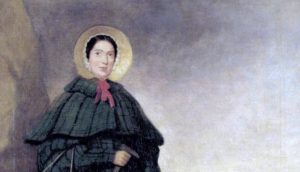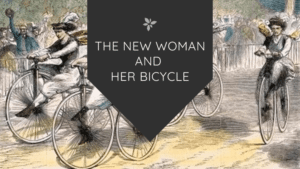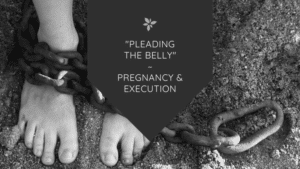Fanny Blankers-Koen (1918–2004) was a Dutch Olympic athlete known as the Flying Housewife. In the 1948 Olympics in London, the 30-year-old mother of two won four gold medals and set world records — while pregnant with her third child. She was the first woman to win four Olympic gold medals, and the first one to do so in a single Olympics.
Born Francina Elsje Koen, Fanny first competed in the 1936 Olympics in Berlin at 18 years old, where she didn’t win but was able to get the autograph of her hero, track and field athlete Jesse Owens. Many years later, she met him again:
When I met him again in Munich at the 1972 Olympics I said, “I still have your autograph, I’m Fanny Blankers-Koen.” He said, “You don’t have to tell me who you are, I know everything about you.” Isn’t that incredible? Jesse Owens knew who I was.
Though Fanny went on to train, setting her first world record and winning international medals, she was unable to compete in the Olympics again for many years: World War II put a stop to the 1940 and 1944 Olympics.
By the time of the first post-war Olympics in 1948 in London, Fanny was 30 years old, and married with a 7-year-old son and 2-year-old daughter. When she had had her first child, many assumed it was the end of her athletic career. At the time, top female athetes who were married were extremely rare, and it was inconceivable that a mother would be an athlete.
“I got very many bad letters, people writing that I must stay home with my children.”
“One newspaperman wrote that I was too old to run, that I should stay at home and take care of my children. When I got to London, I pointed my finger at him and I said: ‘I show you.’“
People also said that at 30 years old, she was too old to be competing. The British athletic team’s manager claimed she was “too old to make the grade”, and many journalists questioned her on her age.
Still, as the leading athlete in the Netherlands, Fanny qualified for the Olympics. She chose four events: the 100 meter, the 200 meter, and 80 meter hurdles, and the 4 x 100 meter relay.
In the 100 meter, she easily sped to the finish line past her opponents, winning her first gold and becoming the first Dutch athlete to win an Olympic title in athletics. In the hurdles, she thought she had been beaten but a close examination of the finish photo clearly showed that she had won again.
Despite her amazing success, Fanny almost withdrew at the end of that day, overcome with homesickness. After a long talk with her husband, who had first been her coach, she decided to stay.
In the pouring rain, Fanny ran the 200-meter, finishing 7/10 of a second before the the runner-up—the largest margin of victory in any Olympic 200m final.
Fanny was a bit late for her final event, the 4×100 relay, because she had gone out to shop for a raincoat. Still, she arrived just in time to compete. She was the last runner in the relay, and her team was behind. But after receiving the baton she managed to overtake the Australian and Canadian competitors and her team came in first, winning Fanny her fourth gold medal in the 1948 Olympics.
Around the world Fanny was dubbed “The Flying Housewife”, “The Flying Dutchmam”, and “Amazing Fanny”. Welcomed home to Amsterdam with an immense crowd, Fanny was showered with praise and gifts, including a bicycle from the city itself so she could “go through life at a slower pace” and “need not run so much”. Queen Juliana of the Netherlands even made her a Knight of the Order of Orange-Nassau, a chivalry order open to “everyone who has earned special merits for society”.
“[T]imes were harsh and people were glad of the opportunity to celebrate anything. It made me proud to know I had been able to bring joy into people’s lives.”
Fanny went on to compete in the 1952 Olympics at the age of 34. After retiring from her athletic career, Blankers-Koen served as the team leader of the Dutch athletics team for several years.
Legacy
“All I’ve done is run fast. I don’t see why people should make much fuss about that.”
The Fanny Blankers-Koen Games, an international athletics event, was established in 1981 in Fanny’s honor. They are still held every year in Hengelo in the Netherlands.
In 1999, Fanny was declared “Female Athlete of the Century” by the International Association of Athletics Federations (IAAF). Even after all her victories and accomplishments, Fanny was astonished, asking “You mean it is me who has won?”
Before Fanny’s four gold win at the 1948 Olympics, women athletes were not taked very seriously and considered in a very condescending way. After Fanny, women’s athletics took on a much more positive light to the world, especially since Fanny had acheived her wins while a wife and mother.

“Her place in athletics is more than just a series of outstanding performances. Her place is historical in the sense that it marked the real beginning for the acceptance on the top athletic level of women. She’s a historical figure beyond the successes she achieved.” ~ journalist Bill Guy
Featured image of Fanny Blankers-Koen courtesy Wikimedia Commons.
Recommended Reading
Keri is a blogger and digital marketing professional who founded Amazing Women In History in 2011.






really enjoyed this. had never heard of her – and that’s a crime! thanks!
Glad you enjoyed it! I loved learning about her too 🙂